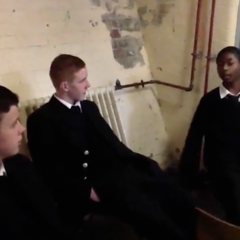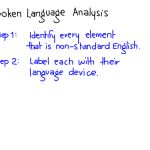Spoken Language Study: Analyse the Transcript
After viewing the excerpt and carefully transcribing the conversation from within, today we began the process of identifying the all the features that deviate from “Standard English”. Here is the result – next we’ll be delving deeper into the linguistic and paralinguistic features of this spoken text and having our second attempt at writing up our conclusions in long form. LINKS: Original excerpt and transcript...
Homework: Mobility of Paralinguistic Features
In class today, everyone made a start on answering the following question. The homework is to complete this, on your personal blog, as a test of the swiftness of the response you will get from me to any work you do there. QUESTION: How do spoken language and text language influence each other? Make a statement Give examples Explain how your examples support your statement NAME the language features you’re using as...
Discriminating Between Spoken and Text Language
Today we explored a wide range of language features that are typical of spoken and multi-modal language and classified them in three categories: (The boys were asked to share with each other the devices or features that they were the most interested in or uncertain of, rather than the ones they were the most sure were correct. We didn’t want the safe answers) Spoken-Only These features of language are only present in spoken...
Technical Terms Specific to Text Language
To follow is a list of features that are commonly found in text language. These are particular to this form of communication. They will assist you in the up-coming tasks where you begin to discriminate between language that is spoken and language that is written. Emoticons – graphic symbols representing emotions Acronyms – use of words’ initial letters to form a single new word e.g. AIDS Initialisms – initial...





